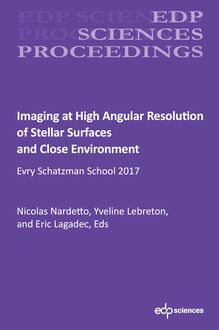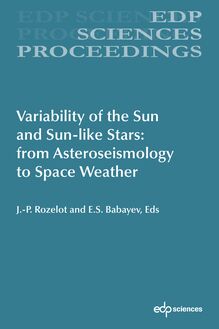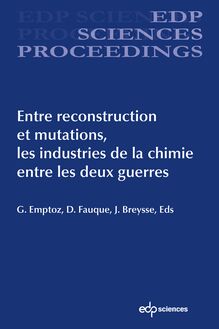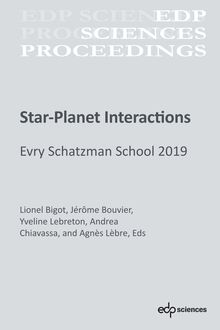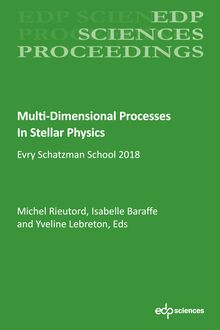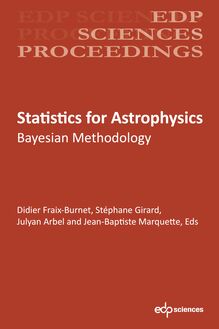Star-Planet Interactions , livre ebook
230
pages
English
Ebooks
2023
Obtenez un accès à la bibliothèque pour le consulter en ligne En savoir plus
Découvre YouScribe en t'inscrivant gratuitement
Découvre YouScribe en t'inscrivant gratuitement
230
pages
English
Ebooks
2023
Obtenez un accès à la bibliothèque pour le consulter en ligne En savoir plus
Publié par
Date de parution
16 février 2023
Nombre de lectures
0
EAN13
9782759831548
Langue
English
Poids de l'ouvrage
77 Mo
The exoplanet revolution that began three decades ago has drastically changed our knowledge of the extra-solar systems. Today, we face an extreme diversity and complexity of these systems that can only be understood through the intimate link that exists between the planets and their host stars. The understanding, characterization, and the detection of the exoplanets has to be made in close collaboration between stellar and planetary physicists. The purpose of the school and this book is to provide an update of our current knowledge in some selected research fields dedicated to the interplay between stars and planets. It aims to prepare scientists for a rich new decade for exoplanets with space missions like the upcoming PLATO and ARIEL and the new instruments on the VLT and the future ELT.
Preface i
Scientific and organising committees ii
Sponsors iii
List of participants iv
I Physics of star-planet magnetic interactions1
1 Introduction 2
1.1 The hot exoplanets population......................... 2
1.2 Observational status of star-planetmagnetic interactions ........... 3
2 Magnetic interactions in compact exosystems:overview 4
2.1 Sub- vs Super-alfvénic interaction....................... 4
2.2 Different regimes of sub-alfvénic interactions ................. 6
3 Magnetic interactions in compact exosystems: the Alfvén wings 7
3.1 Pre-requisites on magneto-hydrodynamic waves ................ 7
3.2 The concept of Alfvén wings.......................... 9
3.3 Energetics of Alfvén wings . . . . . . . .. . . . . . . . . . . . . . . . . . . 12
3.4 Angular momentum transfer and the secular evolution of stellar systems . . . 15
4 Conclusions 17
Bibliography 17
II Stellar variability in radial velocity 22
1 Introduction 23
2 From the instruments to radial velocities 24
2.1 Instruments . . . . . . . . . . . . . . . .. . . . . . . . . . . . . . . . . . . 25
2.2 From spectra to radial velocities . . . . .. . . . . . . . . . . . . . . . . . . 25
2.3 Observational strategies . . . . . . . . .. . . . . . . . . . . . . . . . . . . . 26
2.4 Complementary information: chromospheric emission . . . . . . . . . . . . 27
2.5 Effect of stellar variability on exoplanetstudies in radial velocity: impact and challenges . . . . . . . . . . . . . . . . . . . . 28
3 Stellar processes contributing to radial velocities 29
3.1 General overview . . . . . . . . . . . . .. . . . . . . . . . . . . . . . . . . 29
3.2 Spot and plage contrasts . . . . . . . . .. . . . . . . . . . . . . . . . . . . 30
3.3 Oscillations . . . . . . . . . . . . . . .. . . . . . . . . . . . . . . . . . . . 32
3.4 The granulation . . . . . . . . . . . . . .. . . . . . . . . . . . . . . . . . . 33
3.5 Supergranulation . . . . . . . . . . . . .. . . . . . . . . . . . . . . . . . . 36
3.6 Convective blueshift inhibition in plage .. . . . . . . . . . . . . . . . . . . 37
YL Star-Planet Interactions – Evry Schatzman School 2019
3.7 Evershed flows . . . . . . . . . . . . . .. . . . . . . . . . . . . . . . . . . 38
3.8 Meridional circulation . . . . . . . . . .. . . . . . . . . . . . . . . . . . . 38
3.9 Flares . . . . . . . . . . . . . . . . . .. . . . . . . . . . . . . . . . . . . . 40
4 Approaches to the problem 40
4.1 Mitigating techniques . . . . . . . . . . .. . . . . . . . . . . . . . . . . . . 40
4.2 Simulations . . . . . . . . . . . . . . . .. . . . . . . . . . . . . . . . . . . 43
4.2.1 Simulations with 1-2 spots . . . . . . .. . . . . . . . . . . . . . . . 43
4.2.2 Simulations with complex activity patterns . . . . . . . . . . . . . . 44
4.2.3 Simulations of the small or large scale dynamics . . . . . . . . . . . 50
4.3 Stellar observations: simultaneous campaigns . . . . . . . . . . . . . . . . . 50
4.4 Observations of the Sun as a star . . . . .. . . . . . . . . . . . . . . . . . . 50
5 Conclusion 51
Bibliography 52
III Stellar activity and transits 65
1 Introduction 66
2 Solar and stellar activity observations 67
3 High precision photometry 68
3.1 Stellar rotation periods . . . . . . . . .. . . . . . . . . . . . . . . . . . . . 69
3.2 Stellar surface reconstruction . . . . . .. . . . . . . . . . . . . . . . . . . . 71
3.3 Stellar differential rotation and star spot evolution . . . . . . . . . . . . . . . 72
4 Planetary transits and stellar activity features in photometry 73
4.1 Effect of non-occulted activity features on the transit depth . . . . . . . . . . 74
4.2 Effect of occulted activity features . . .. . . . . . . . . . . . . . . . . . . . 75
5 Starspots and faculae in transmission spectroscopy 77
6 Effects on other transit parameters 80
7 Planetary transits and stellar granulation 84
7.1 Effect on measured stellar parameters . . .. . . . . . . . . . . . . . . . . . 84
7.2 Effect on transit parameters . . . . . . .. . . . . . . . . . . . . . . . . . . . 84
8 Conclusions 86
Bibliography 87
IV High resolution spectroscopy for exoplanet characterisation 103
1 Introductory concepts 104
1.1 The underlying scientific questions . . . .. . . . . . . . . . . . . . . . . . . 104
1.2 Resolution vs Resolving Power . . . . . . .. . . . . . . . . . . . . . . . . . 106
1.3 Using spectroscopy to find exoplanets . . .. . . . . . . . . . . . . . . . . . 107
1.4 Exoplanets and their orbits . . . . . . . .. . . . . . . . . . . . . . . . . . . 108
1.5 Spectroscopy of transiting exoplanets . . .. . . . . . . . . . . . . . . . . . 109
1.5.1 Transmission spectroscopy . . . . . . . .. . . . . . . . . . . . . . . 109
1.5.2 Information from secondary eclipses: reflected light . . . . . . . . . 112
1.5.3 Information from secondary eclipses: thermal emission . . . . . . . . 113
1.5.4 Information from the whole orbit: phase curves . . . . . . . . . . . . 114
2 High-resolution spectroscopy of exoplanets115
2.1 Key characteristics . . . . . . . . . . . .. . . . . . . . . . . . . . . . . . . 115
2.2 The signal-to-noise formula and cross correlation . . . . . . . . . . . . . . . 116
2.3 Understanding the analysis of high-resolution exoplanet spectra . . . . . . . 118
2.4 Molecular and atomic species detected . . .. . . . . . . . . . . . . . . . . . 122
2.5 Thermal inversion layers . . . . . . . . .. . . . . . . . . . . . . . . . . . . 123
2.6 From demonstration to comparative exoplanetology . . . . . . . . . . . . . . 124
2.7 Follow-up of TESS exoplanets . . . . . . .. . . . . . . . . . . . . . . . . . 126
2.8 Cloudy atmospheres at high spectral resolution . . . . . . . . . . . . . . . . 127
3 The star as a source of astrophysical noise129
3.1 Stellar spectra are non-stationary . . . .. . . . . . . . . . . . . . . . . . . . 130
3.2 Stellar cross-correlation noise in day-side observations of exoplanets . . . . . 131
3.3 Stellar spectra are distorted during transit . . . . . . . . . . . . . . . . . . . 131
3.4 Modelling the background stellar spectrum .. . . . . . . . . . . . . . . . . 133
3.5 Stellar modelling to accurately measure exoplanet winds and rotation . . . . 135
4 Estimating significance and error bars 137
4.1 The signal-to-noise approach . . . . . . .. . . . . . . . . . . . . . . . . . . 137
4.2 The Welch t-test . . . . . . . . . . . . .. . . . . . . . . . . . . . . . . . . . 138
4.3 Estimating the “model” cross correlation function . . . . . . . . . . . . . . . 139
4.4 Bayesian analysis on high-resolution spectra . . . . . . . . . . . . . . . . . . 140
4.4.1 Combining low- and high-resolution spectroscopy . . . . . . . . . . 141
5 Bridging the gap towards habitable planets141
5.1 Planets around M-dwarf stars . . . . . . .. . . . . . . . . . . . . . . . . . . 141
5.1.1 Detecting oxygen in planets around M-dwarfs . . . . . . . . . . . . . 143
5.1.2 Challenges in M-dwarf observations . . .. . . . . . . . . . . . . . . 143
5.2 Combining spectral and spatial resolution .. . . . . . . . . . . . . . . . . . 144
Bibliography 145
V Stellar Winds and Planetary Atmospheres 154
1 Introduction 155
2 Stellar rotation and activity evolution 158
2.1 The observational picture . . . . . . . . .. . . . . . . . . . . . . . . . . . . 158
2.2 The epochs of rotational evolution . . . .. . . . . . . . . . . . . . . . . . . 160
2.3 Activity and rotation . . . . . . . . . . .. . . . . . . . . . . . . . . . . . . 161
2.4 Activity evolution . . . . . . . . . . . .. . . . . . . . . . . . . . . . . . . . 163
3 Properties and Evolution of Stellar Winds 164
3.1 Observational constraints on winds . . . .. . . . . . . . . . . . . . . . . . . 164
3.1.1 Rotational evolution . . . . . . . . . .. . . . . . . . . . . . . . . . 164
3.1.2 Radio observations . . . . . . . . . . .. . . . . . . . . . . . . . . . 166
3.1.3 Interactions with the interstellar medium. . . . . . . . . . . . . . . 166
3.1.4 Effects on planetary companions . . . . .. . . . . . . . . . . . . . . 168
3.2 Solar wind: basic properties . . . . . . .. . . . . . . . . . . . . . . . . . . 168
3.3 Wind physics . . . . . . . . . . . . . . .. . . . . . . . . . . . . . . . . . . 171
3.4 Winds of active stars . . . . . . . . . . .. . . . . . . . . . . . . . . . . . . 172
3.5 Coronal mass ejections . . . . . . . . . .. . . . . . . . . . . . . . . . . . . 174
4 Earth’s Upper Atmosphere and Wind Interactions 174
4.1 The vertical structure of the Earth’s atmosphere . . . . . . . . . . . . . . . . 175
4.2 Exospheres, magnetospheres, and winds . . .. . . . . . . . . . . . . . . . . 177
5 Planetary Upper Atmospheres and Escape 179
5.1 Hydrodynamic escape . . . . . . . . . . . .. . . . . . . . . . . . . . . . . . 180
5.2 Upper atmospheres and active stars . . . .. . . . . . . . . . . . . . . . . . . 182
5.3 The importance of atmospheric cooling . . .. . . . . . . . . . . . . . . . . 184
5.4 The importance of the star’s rotational evolution . . . . . . . . . . . . . . . . 184
5.5 Stellar winds, CMEs, and habitable zone planets . . . . . . . . . . . . . . . . 186
6 Discussion 187
Bibliography 188
VI Main ways in which stars influence theclimate and surface hab[1]itability of theirplanets 202
1 Introduction 203
2 Influence of the bolometric emissiondistribution on the climate 205
3 Influence of the UV emission on the photochemistry 208
4 Influence of the X-EUV emission on atmospheric loss 209
5 Influence of the temporal evolution of the stellar emissions 210
6 Conclusions 211
Bibliography 212
Publié par
Date de parution
16 février 2023
Nombre de lectures
0
EAN13
9782759831548
Langue
English
Poids de l'ouvrage
77 Mo
Star-Planet Interactions
Evry Schatzman School 2019
Lionel Bigot, Jérôme Bouvier,
Yveline Lebreton, Andrea
Chiavassa, and Agnès Lèbre, EdsPrinted in France
ISBN(print): 978-2-7598-3153-1 – ISBN(ebook): 978-2-7598-3154-8
All rights relative to translation, adaptation and reproduction by any means whatsoever
are reserved, worldwide. In accordance with the terms of paragraphs 2 and 3 of Article 41
of the French Act dated March 11, 1957, “copies or reproductions reserved strictly for
private use and not intended for collective use” and, on the other hand, analyses and short
quotations for example or illustrative purposes, are allowed. Otherwise, “any
representation or reproduction – whether in full or in part – without the consent of the
author or of his successors or assigns, is unlawful” (Article 40, paragraph 1). Any or reproduction, by any means whatsoever, will therefore be deemed an
infringement of copyright punishable under Articles 425 and following of the French Penal
Code.
© EDP Sciences, 2023 Preface
The exoplanet revolution that began nearly three decades ago with the discovery of the frst
planet around a Sun-like star, has drastically changed our understanding of the formation
of extra-solar systems. Today, we face an extreme diversity and complexity of these
systems that can only be understood through the intimate link that exists between the planets
and their host stars like tides, winds, and magnetic interactions. We are now in a
position to detect planets down to Earth analogues thanks to space-borne missions like Kepler,
TESS, and soon PLATO, and ground-based instruments installed on large telescopes like
ESO/HARPS, CAHA/CARMENES, and CFHT/SPIRou. The detection and characterization
of telluric planets is one of the main challenges of modern astrophysics. The difculty lies in
both detecting them and characterizing their properties and atmospheric composition, while
the planetary signal is contaminated, if not drowned into the "noise" of the stellar activity.
In this respect, the advent of a new and exciting new generation of instruments, like the
James Webb Space Telescope, and ground-based instruments like CRIRES+ at VLT and in a
near future PCS or ANDES at the E-ELT, will open a new area in exoplanet study with the
detection of possible life tracers.
The 2019 edition of the Evry Schatzman School (EES 2019) of the CNRS/INSU French
National Program for Stellar Physics (PNPS) was held in Aussois (France) from September
123 to 27 . The aim of the school was to provide an overview of the new challenges
related to exoplanetary systems with lectures on the characterisation of stellar variability which
generates some "noise" for exoplanet detection (N. Meunier, G. Bruno), on star and planet
interactions and their interplay with tides (S. Mathis), with magnetism (A. Strugarek), and on
the impact of stellar winds on their companions (C. Johnstone). The challenges brought by
exoplanets require an in-depth understanding of these stellar processes that are beyond the
standard models of stellar structure and atmospheres. Another quest for astronomers is the
characterisation of the atmospheres of exoplanets and, hopefully, the detection of biomarkers.
These two topics were covered during the school through lectures on the defnition and
conditions of habitability (M. Turbet), and on the state-of-the-art techniques of detection of atoms
and molecules in the atmosphere of exoplanets by transmission spectroscopy (M. Brogi). The
school additionally ofered hands-on sessions on tools used to overcome the impact of stellar
noise, like Gaussian Processes (S. Aigrain), and the code SOAP to handle brightness features
such as spots and plages on the stellar disk to estimate their impact on planet detection (M.
Oshagh). All the material (slides of the talks and codes) are freely available on the website
of the school. All the lecture notes in this book are also available on Arxiv.
We warmly thank our colleagues for the quality of the lectures and discussions during
EES 2019; the students for their active participation with posters, presentations, discussions,
and overall their enthusiasm; our sponsors: Centre National de la Recherche Scientifque
(CNRS), Programme National de Physique Stellaire (PNPS) and Planétologie (PNP),
Université de la Côte d’Azur (UCA), ERC SPIDI (grant agreement 742095), the Lagrange
Laboratory and the Observatoire de la Côte d’Azur (OCA); the local organizing committee: C.
Delobelle, S. Rousset, and I. Lapassat for managing the administrative and coordination
aspects. We are also very much grateful to the stafof the Paul Langevin center for their warm
welcome and all the eforts they put to make our stay fruitful and pleasant during that week,
despite the on-going renovation of the center. We were glad to bring back the EES school at
2its original place in Aussois, where Evry Schatzman and Annie Baglin started this series , 30
years before the EES 2019.
L. Bigot, J. Bouvier, Y. Lebreton, A. Chiavassa, & A. Lèbre, the Editors
1https://ees2019.sciencesconf.org
2https://www.pnps.cnrs.fr/ees.htmlii Star-Planet Interactions – Evry Schatzman School 2019
Poster of the school. Image Copyrights ESO/Calçada
Scientifc and organising committees
Scientifc committee
L. Bigot (Chair) - Université Côte d’Azur, OCA, CNRS, Lagrange, F-06304 Nice, France
J. Bouvier (co-Chair) - Institut de Planétologie de Grenoble, Grenoble, France
Y. Lebreton - LESIA, Observatoire de Paris, PSL Research University, CNRS, Sorbonne
Université, Univ. Paris Diderot, Sorbonne Paris Cité, Meudon 92195, France and Univ
Rennes, CNRS, IPR (Institut de Physique de Rennes)-UMR 6251, F-35000 Rennes, France
A. Chiavassa - Université Côte d’Azur, OCA, CNRS, Lagrange, F-06304 Nice, France
A. Lèbre - Laboratoire univers et particules de Montpellier, Montpellier, France
Local committee
L. Bigot (Chair) - Université Côte d’Azur, OCA, CNRS, Lagrange, F-06304 Nice, France
A. Chiavassa - Université Côte d’Azur, OCA, CNRS, F-06304 Nice, France
C. Delobelle - Université Côte, OCA, Lagrange, Nice,
I. Bailet - Université Côte d’Azur, OCA, CNRS, Lagrange, F-06304 Nice, France
S. Rousset - Université Côte d’Azur, OCA, CNRS, Lagrange, F-06304 Nice, FranceSponsors iii
The sponsors of the EES2019iv Star-Planet Interactions – Evry Schatzman School 2019
List of participants
1. Jérémy Auir, CEA - Département d’Astrophysique / Laboratoire AIM
2. Suzanne Aigrain (Lecturer), Department of Physics, University of Oxford
3. Lionel Bigot (Chair), Lagrange, Observatoire de la Côte d’Azur
4. Jerome Bouvier (co-Chair), Université Grenoble Alpes, CNRS, IPAG, 38000
Grenoble, France
5. Matteo Brogi (Lecturer), Department of Physics, University of Warwick
6. Giovanni Bruno (Lecturer), Catania Astrophysical Observatory, INAF
7. Tianqi Cang, IRAP, Observatoire Midi-Pyrénées
8. Andrea Chiavassa (SOC), Lagrange, Observatoire de la Côte d’Azur
9. Martin Farnir, STAR Institute, Université de Liège
10. Eric Fossat, Lagrange, Observatoire de la Côte d’Azur
11. Guillaume Gaisné, Institut de Planétologie et d’Astrophysique de Grenoble
12. Lionel Garcia, Université de Liège
13. Kieran Hirsh, CRAL, Univ-Lyon 1
14. Colin Johnstone (Lecturer), University of Vienna - Dep. of Astrophysic
15. Anand Utsav Kapoor
16. Laurel Kaye, Department of Physics, University of Oxford
17. Agnes Lebre (SOC), LUPM, Université de Montpellier
18. Yveline Lebreton (SOC), LESIA, Observatoire de Meudon
19. Louis Manchon, IAS, Université Paris Sud
20. Stéphane Mathis (Lecturer), CEA - Département d’Astrophysique / Laboratoire AIM
21. Nadège Meunier (Lecturer), Institut de Planétologie et d’Astrophysique de Grenoble
22. Belinda Nicholson, Department of Physics, University of Oxford
23. Mahmoudreza Oshagh, Inst. for Astrophysics, Georg-August-Univ. of Göttingen
24. George Pantolmos, Institut de Planétologie et d’Astrophysique de Grenoble
25. Camilla Pezzotti, University of Geneva, Observatory of Geneva
26. Jordan Philidet, LESIA, Observatoire de Paris
27. Charly Pinçon, Université de Liège
28. Kim Pouilly, Institut de Planétologie et d’Astrophysique de Grenoble
29. Noemi Roggero, Institut de et d’Astrophysique de GrenobleList of participants v
30. Melaine Saillenfest, IMCCE, Observatoire de Paris
31. Antoine Strugarek (Lecturer), CEA - Département d’Astrophysique / Laboratoire
AIM
32. Sophia Sulis, Space Research Institute, Austrian Academy of Sciences
33. Martin Turbet (Lecturer), University of Geneva, Observatory of Geneva, Versoix,
Switzerland
34. Arnaud Vericel, Centre de Recherche Astrophysique de Lyon, Université Claude
Bernard Lyon 1
Participants of the EES2019vi Star-Planet Interactions – Evry Schatzman School 2019
Contents
Preface i
Scientifc and organising committees ii
Sponsors iii
List of participants iv
I Physics of star-planet magnetic interactions 1
1 Introduction 2
1.1 The hot exoplanets population . . . . . . . . . . . . . . . . . . . . . . . . . 2
1.2 Observational status of star-planet magnetic interactions . . . . . . . . . . . 3
2 Magnetic interactions in compact exosystems: overview 4
2.1 Sub- vs Super-alfvénic interaction . . . . . . . . . . . . . . . . . . . . . . . 4
2.2 Diferent regimes of sub-alfvénic interactions . . . . . . . . . . . . . . . . . 6
3 Magnetic interactions in compact exosystems: the Alfvén wings 7
3.1 Pre-requisites on magneto-hydrodynamic waves . . . . . . . . . . . . . . . . 7
3.2 The concept of Alfvén wings . . . . . . . . . . . . . . . . . . . . . . . . . . 9
3.3 Energetics of Alfvén wings . . . . . . . . . . . . . . . . . . . . . . . . . . . 12
3.4 Angular momentum transfer and the secular evolution of stellar systems . . . 15
4 Conclusions 17
Bibliography 17
II Stellar variability in radial velocity 22
1 Introduction 23
2 From the instruments to radial velocities 24
2.1 Instruments . . . . . . . . . . . . . . . . . . . . . . . . . . . . . . . . . . . 25
2.2 From spectra to radial velocities . . . . . . . . . . . . . . . . . . . . . . . . 25
2
